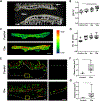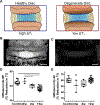Intervertebral Disc Degeneration Is Associated With Aberrant Endplate Remodeling and Reduced Small Molecule Transport
- PMID: 32176817
- PMCID: PMC8207249
- DOI: 10.1002/jbmr.4009
Intervertebral Disc Degeneration Is Associated With Aberrant Endplate Remodeling and Reduced Small Molecule Transport
Abstract
The intervertebral disc is the largest avascular structure in the body, and cells within the disc rely on diffusive transport via vasculature located within the vertebral endplate to receive nutrients, eliminate waste products, and maintain disc health. However, the mechanisms by which small molecule transport into the disc occurs in vivo and how these parameters change with disc degeneration remain understudied. Here, we utilize an in vivo rabbit puncture disc degeneration model to study these interactions and provide evidence that remodeling of the endplate adjacent to the disc occurs concomitant with degeneration. Our results identify significant increases in endplate bone volume fraction, increases in microscale stiffness of the soft tissue interfaces between the disc and vertebral bone, and reductions in endplate vascularity and small molecule transport into the disc as a function of degenerative state. A neural network model identified changes in diffusion into the disc as the most significant predictor of disc degeneration. These findings support the critical role of trans-endplate transport in disease progression and will improve patient selection to direct appropriate surgical intervention and inform new therapeutic approaches to improve disc health. © 2020 American Society for Bone and Mineral Research. Published 2020. This article is a U.S. Government work and is in the public domain in the USA.
Keywords: ANIMAL MODELS; BONE REMODELING; INTERVERTEBRAL DISC DEGENERATION; SMALL MOLECULE DIFFUSION; VASCULARITY.
Published 2020. This article is a U.S. Government work and is in the public domain in the USA.
Conflict of interest statement
Disclosures
RLM is the editor of
Figures





Similar articles
-
Dynamic adaptation of vertebral endplate and trabecular bone following annular injury in a rat model of degenerative disc disease.Spine J. 2018 Nov;18(11):2091-2101. doi: 10.1016/j.spinee.2018.05.045. Epub 2018 Jun 8. Spine J. 2018. PMID: 29886163
-
Human disc nucleus properties and vertebral endplate permeability.Spine (Phila Pa 1976). 2011 Apr 1;36(7):512-20. doi: 10.1097/BRS.0b013e3181f72b94. Spine (Phila Pa 1976). 2011. PMID: 21240044 Free PMC article.
-
Osteoporosis of the vertebra and osteochondral remodeling of the endplate causes intervertebral disc degeneration in ovariectomized mice.Arthritis Res Ther. 2018 Sep 10;20(1):207. doi: 10.1186/s13075-018-1701-1. Arthritis Res Ther. 2018. PMID: 30201052 Free PMC article.
-
[VERTEBRAL SUBCHONDRAL BONE AND INTERVERTEBRAL DISC DEGENERATION].Zhongguo Xiu Fu Chong Jian Wai Ke Za Zhi. 2015 Mar;29(3):377-80. Zhongguo Xiu Fu Chong Jian Wai Ke Za Zhi. 2015. PMID: 26455209 Review. Chinese.
-
Animal Models of Internal Endplate Injury-Induced Intervertebral Disc Degeneration: A Systematic Review.J Invest Surg. 2024 Dec;37(1):2400478. doi: 10.1080/08941939.2024.2400478. Epub 2024 Sep 10. J Invest Surg. 2024. PMID: 39255967
Cited by
-
A Long-Term Retrospective Observational Clinical Study Evaluating the Efficacy of Plasma Rich in Growth Factors (PRGF) in the Treatment of Back Pain.Pain Ther. 2025 Apr;14(2):675-690. doi: 10.1007/s40122-024-00699-y. Epub 2025 Jan 16. Pain Ther. 2025. PMID: 39821506 Free PMC article.
-
Activation of LAMP1-mediated lipophagy by sulforaphane inhibits cellular senescence and intervertebral disc degeneration.J Orthop Translat. 2025 Jun 2;53:12-25. doi: 10.1016/j.jot.2025.05.010. eCollection 2025 Jul. J Orthop Translat. 2025. PMID: 40525097 Free PMC article.
-
Deliver CEBPE via cartilage targeting Lipid nanoparticle to block CEBPE-LTF-STAT3 positive feedback loop for efficient treatment of cartilage endplate degeneration.Mater Today Bio. 2025 Jun 28;33:102027. doi: 10.1016/j.mtbio.2025.102027. eCollection 2025 Aug. Mater Today Bio. 2025. PMID: 40677394 Free PMC article.
-
Osteopontin deficiency promotes cartilaginous endplate degeneration by enhancing the NF-κB signaling to recruit macrophages and activate the NLRP3 inflammasome.Bone Res. 2024 Sep 6;12(1):53. doi: 10.1038/s41413-024-00355-3. Bone Res. 2024. PMID: 39242551 Free PMC article.
-
3D assessment of intervertebral disc degeneration in zebrafish identifies changes in bone density that prime disc disease.Bone Res. 2021 Aug 31;9(1):39. doi: 10.1038/s41413-021-00156-y. Bone Res. 2021. PMID: 34465741 Free PMC article.
References
-
- Cassidy JJ, Hiltner A, Baer E. Hierarchical structure of the intervertebral disc. Connect Tissue Res. 1989;23(1):75–88. - PubMed
-
- Huang Y-sC, Urban JPG, Luk KDK. Intervertebral disc regeneration: do nutrients lead the way? Nat Rev Rheumatol. 2014;10(9):561–6. - PubMed
-
- Roberts S, Menage J, Urban JPG. Biochemical and structural properties of the cartilage end-plate and its relation to the intervertebral disc. Spine. 1989;14(2):166–74. - PubMed

